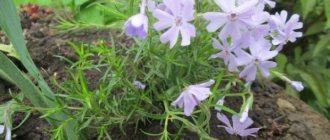Types and varieties of gillyflower
Levkoi is translated from Greek as “white violet”. Initially, levkoys, or matthiolas, as they are otherwise called, were only white. They smelled, as they do now, very strongly. Among modern varieties there are annual, biennial and perennial plants.
Levkoys have 22 species and hundreds of hybrids and varieties. Among the species, the most famous are gray-haired Levka, fragrant, Tatar, long-petaled. And the varieties are created on the basis of the most famous gray-haired Levkoy or Mattiola gray. On packets of seeds you can see both names.
The root system of matthiola is taprooted, but lies shallow, so it needs regular watering. Almost all species have pubescence on the stem and leaves. Small fibers on the leaves act as reservoirs that nourish the plant during heat. They also protect against external influences.
Gray-haired Levkoy or Gray-haired Mattiola
Levka grey-haired is called so because its pubescent stem and leaves appear gray. These are annual species of gillyflower, with a height of 20 to 80 cm. The stem is sometimes branched, but most often there are species with an erect stem. The leaves are most often narrow or lanceolate, sometimes wide obovate, tapering towards the petiole. On the stem they are arranged in a regular order. The color of the leaves, like the stem, is dark green, with grayish or silvery pubescence.
The flowers of modern varieties are double, in some cases semi-double. They are collected in loose inflorescences in the form of a brush or spike. The flowers have a strong smell, even after cutting. They have a variety of colors: from white to dark pink. There are varieties with yellow flowers. There are several varieties of gray-haired left-handed grass:
Levkoy Giant lavender . The height of the plant reaches 60 cm. The variety is distinguished by its large flower size and long flowering. The color of this variety is beautiful: lavender, with a hint of pink.
Excelsior F1 . A plant with a semi-lignified stem, up to 70 cm high. Blooms from June to September. The flowers are large, yellow in color, some reaching 5 cm in diameter, collected in large loose clusters. The flower is very beautiful and fragrant.
Lapis lazuli . Low, only about 40 cm, a variety with cute blue flowers collected in brushes. The flowers are quite large for such a baby, 3-5 cm in diameter. Blooms from mid-summer to September.
Red Viking . This variety has all double flowers, 5-6 cm in diameter. The height of the plant is up to 60 cm. It is used in group plantings near the house and bench to give the flower garden a special charm in the form of ruby flowers with a delicate aroma.
White giant . Tall plant up to 70 cm. Stems are straight, semi-lignified, leaves are diamond-shaped, large. White flowers are densely arranged on the inflorescence. This variety is characterized by a high degree of terry.
Blue Viking . This variety has fairly dense inflorescences, which consist of double flowers. Thanks to this, it has a very long flowering period, 1.5 months.
Swing . Not a very tall variety of gillyflower, only 40 cm. It is distinguished by large, 5-6 cm, double yellow flowers. It blooms for a long time, provided it is planted through seedlings - from the beginning of June to the end of August.
Kwik . A plant with a semi-lignified stem, 40 cm high. The diameter of a strongly double flower is 5-6 cm. Due to the fact that the variety is not tall, it can be planted in boxes on balconies. You just need to find such “neighbors” so that they combine with the bright red fragrant flowers of the gillyflower.
Fox . Low, no more than 40 cm, in open ground and 30-35 cm in pots or flowerpots. The flowers are beautiful, double, 3-4.5 cm in diameter, pure pink. Blooms for a long time.
It should be noted that the flowers of the gray gillyflower, despite the apparent similarity, are very different. Inflorescences can contain from 10 to 60 flowers of completely different colors and sizes.
If the flower is simple, then it blooms for no more than 5 days. Terry varieties of gillyflower bloom for up to 3 weeks.
After flowering, gilly leaves set a long, narrow fruit, a pod, which ripens in about a month. Seeds of grey-headed gillyflower remain viable for 4 to 6 years.
Levkoy fragrant or Levkoy fragrant
Levkoy (matthiola) fragrant - a perennial plant belongs to the cabbage family, like all gillyflowers. It is very fragrant, but the appearance is rather unsightly. This perennial grows on rocks and stones in the steppe. Currently listed in the Red Book.
The stem is branched, has whitish-tomentose pubescence, just like the leaves. The leaves are elongated, with a carved edge. The height of the plant is from 20 to 50 cm, depending on where the plant grows.
The fragrant gillyflower has 4 petals, the color is brown. This type of matthiola blooms in May, sometimes in June. It does not bloom long, each flower fades after 4 days. In August the fruit ripens in the form of a pod.
Levkoy long-petalled
Long-petaled gillyflower is very rare in nature. It is not grown as a cultivated plant. It has long leaves with a slightly serrated edge and inconspicuous flowers with a strong aroma.
Levkoy Tatar
The Tartarian Levkoy is found in arid areas. Grows on rocks and sands. It has little in common with the lefty we know. Long leaves are collected in a rosette near the surface of the ground. The flowers are small, reddish in color, collected in very loose inflorescences.
general information
Levkoy is a subshrub of not the most impressive size - about 50 cm on average. True, it depends on the variety, because there are dwarfs and giants. Various species are successfully grown as annuals or perennials.
Levkoy is famous for its aroma that fills the garden after sunset. It has straight branched shoots with large leaves and the same large inflorescences of pink, white, red or purple. There are varieties with double and single flowers, and both varieties can be grown from one batch of seeds.
Photo: avto.goodfon.ru
Terry coefficient
Sometimes, when mentioning levkoys, they note such a feature as their terry nature. Moreover, we are talking about a certain indicator, that is, a coefficient. One matthiola or grey-headed gillyflower plant has both double and single flowers. Their ratio shows the terry coefficient.
Plants with a higher index, for example 90%, have a larger number of double flowers and look more decorative than, for example, bushes with 50% double flowers. As you can guess, about half of these flowers will be regular, and half double. The higher this indicator, the more expensive the seeds will be.
A double flower not only looks better in an inflorescence, but also blooms much longer than a simple one. But it also has its drawbacks. Such flowers are sterile and do not produce seeds. But in place of simple flowers, pods with seeds appear. The leaves of terry gillyflowers are lighter and larger than usual.
Growing gillyflower through seedlings
In order to get flowering earlier, gilly leaves are grown through seedlings. If you sow flowers in the ground in early May, the plant will bloom only in early August. That is why experienced gardeners prefer to plant already grown bushes in the ground. In this case, they can bloom as early as June.
Late seedlings will bloom in July. But in both cases, gilly leaves will delight their owners until September, and sometimes until the very frosts. Pre-grown seedlings will help prevent some problems.
It is easier to grow gilly leaves through seedlings for one more reason. Nowadays, manufacturers put very few seeds in bags. If the hybrid is very rare, then there may be 3-4 of them, no more. By sowing them in open ground, we expose ourselves to the risk of ending up with no flowers at all. Small seeds may become buried or, on the contrary, they may be pushed up. Birds or insects may feast on our rare seeds.
When to sow seedlings
Levkoi are usually sown in March. These plants do not differ greatly in flowering times, so practicing gardeners have no differences in when this should be done. Of course, those who have a cold summer and it starts later sow later. Those who live further south can sow seeds as early as early March.
If there are conditions for growing seedlings not in a hot apartment, but in conditions of good lighting and suitable temperature conditions, then you can sow the seeds a little earlier, in February, and get flowering already in late May-early June. Heated greenhouses or loggias are suitable for this, provided the windows face south.
Preparing seeds before planting
Before planting, seeds can be disinfected in a solution of potassium permanganate. To ensure that the seeds do not disappear, they are placed in a gauze or linen bag, which is dipped into the solution for 15-20 minutes. After this, the seeds must be thoroughly rinsed with clean water.
Next is soaking the seeds for 8-20 hours. This procedure should be carried out only in a small amount of water. Make sure that it does not cover the bags with seeds, otherwise the seeds may “suffocate” and not germinate at all.
But you also need to be wary of drying out, because the seed, as it swells, begins to develop. To maintain the life of the embryo, it needs moisture. Its absence for a long time can destroy the embryo and the seed will not be able to germinate again.
The swollen and enlarged seeds are placed on the bottom shelf of the refrigerator in a wet cloth. This is how they harden. At the end of this procedure, the seeds are ready for sowing.
Soil for growing seedlings
For better germination of matthiola or gillyflower seeds, the soil should be light and breathable. This can be achieved by adding perlite or vermiculite to the substrate. If there is neither one nor the other, then add sifted and calcined sand to the prepared soil mixture.
If you take purchased soil, you can use the one that is marked “For cacti or succulents.” It is loose, it contains sand, and high-quality seeds will sprout very quickly. And then you can transplant it into a more nutritious mixture. To prepare the substrate yourself you need to take:
- 3 parts of garden soil;
- 1 part humus or rotted compost;
- 1 part of turf land.
All parts indicated are taken by volume, not by weight. In winter, you can leave a bag with the prepared mixture on the balcony. There it will freeze thoroughly, which will kill all pathogenic microbes and fungi. A liter of ash and 2 tablespoons of superphosphate are added to a bucket of this mixture.
The mixture must be sifted through a sieve.
Sowing seeds for seedlings
For sowing seeds, low bowls with sides, 5-7 cm high, are used. The soil in them will not sour. It is necessary to make drainage holes at the bottom. Sprinkle a little vermiculite into the prepared soil to help the seeds germinate better.
The seeds are laid out on soil moistened with water. This is done with a toothpick at a distance of at least 2-3 cm from each other, and then sprinkled with earth. To maintain moisture, you need to cover the bowls with seeds with glass or put on a plastic bag, which needs to be removed and ventilated 3-4 times a day.
Conditions for seed germination
In order for the seeds to germinate on the fifth day, you need to maintain a high temperature and high humidity. The seeds germinate better at a temperature of 20-25°C; the warmer it is, the faster this will happen. After the first shoots appear, the temperature is gradually reduced to 16-18°C, and the container with seedlings is placed in the light or under a lamp. This must be done so that the seedlings do not stretch.
The package must be removed, but this must be done gradually. On the first day, the bag is removed for an hour, on the second - for two, and so on. After the temperature drops, you need to carefully monitor watering and avoid overwatering.
Seedling care
Caring for gillyflower seedlings comes down to timely watering and maintaining the temperature within 16-20 degrees. A month after the emergence of seedlings, the seedlings are fed with complete mineral fertilizer. For normal development, gillyflower seedlings need constant moderate watering.
Picking
10 days after mass shoots appear, the seedlings can be planted in separate cups. The signal will be the formation of one or two true leaves on the plants. You need to focus on this, and not on age. One seedling may be 10 days old, another 2 weeks old.
The word "dive" comes from "pike", that is, a stick with a pointed end. With its help, you can painlessly replant the plant. It is convenient to use a wooden stick or an old fork in this case. A spoon or special spatula will not work here.
The algorithm of actions is approximately as follows:
- An hour or two before transplanting, you need to water the plants intended for picking.
- The pots are filled with a nutrient mixture.
- Make a hole with your finger or some other device.
- Remove the plant, being careful not to damage the root system, from the general container. Levkoys have a tap root, which simplifies the task.
- Holding the cotyledon leaves with your fingers, lower the roots of the gillyflower into the hole and cover them with soil.
- Compress the soil around the plant and water without using fertilizers.
For the first time after transplantation, the plant does not need to be watered, especially with the use of fertilizers. The root system should straighten out and begin to grow. Too damp soil inhibits the development of suction roots.
Hardening of seedlings
Hardening off seedlings is a necessary measure to strengthen the plant’s immunity before planting in open ground. When transplanted without prior preparation, the plant experiences severe stress because the microclimate changes dramatically. Levkoy is not a capricious flower, but it also needs gradual hardening.
Approximately 2 weeks before planting in open ground, the plant begins to harden. On the first day, he is taken outside for an hour. This is usually done in the warmest time of the day, but so that the direct rays of the spring sun do not harm the tender seedlings. If necessary, you need to do shading.
Hardened seedlings are distinguished by the fact that they are strong and do not stretch. A distinctive feature is that lefties get sick less. The stress that levkoys experience is minimal. Hardening prepares the plant for new conditions.
Planting gillyflower seedlings in open ground
Under no circumstances should you plant gilly leaves where cruciferous crops grew the previous year. Fungal spores or pathogenic microbes that are causative agents of various diseases can persist in the soil. The main dangers are clubroot and blackleg.
You cannot take soil for leftovers from beds where cabbages were grown: all types of cabbage, radishes, horseradish, radishes. In order to further disinfect the soil, it is spilled with a dark solution of potassium permanganate.
Soil preparation
The soil for flowers must be prepared in advance. Excess nitrogen is harmful for left-handed leaves, so in no case do we add fresh manure to the matthiola (left-handed leaves). Otherwise, all energy will be spent on the growth of green mass, and not on flowering.
For long and lush flowering, it is important for the plant to receive phosphorus, potassium and calcium in a timely manner. They are contained in ash and in complex mineral fertilizers. During spring digging, both ash and superphosphate are added.
The ash should not come from burning bags or plastic. Most potassium is contained in the ash obtained from burning sunflower stems and buckwheat straw. Calcium - after burning: birch, pine and spruce firewood.
Preparing holes and planting
The holes must be prepared in advance. This is necessary so that the dug up loosened soil settles a little. A handful of humus or rotted compost is poured into the hole. If ash and phosphorus fertilizers were not added during digging, then this is done immediately before planting the seedlings.
A little ash and superphosphate are poured into each hole. To prevent the gillyflower root from coming into contact with fertilizers, they are sprinkled with a little soil or sand. Carefully remove it from the seedling pots with a leftover and place it in the hole. Having covered it with soil, water the plant. You can do this in advance by thoroughly watering the hole before planting.
When to plant seedlings in the ground
Healthy planting material must be planted in prepared soil on time. In the middle zone, seedlings are planted in the ground in the second half of May-early June. Plant in a sunny or semi-shaded location. In this case, the growing site must be protected from cold winds.
Levy can survive a short drop in temperature. Even at 2-3°C it will not die. But at this time it is better not to water the plant and monitor the night temperature.
Scheme of planting seedlings
The distance between the leaves depends on the height of the plant. The higher the gillyflower, the more magnificent it is, the more space it will need for full flowering. If a distance of 15 cm is left between low-growing varieties, then tall varieties need twice as much space. They are planted at a distance of 30 cm.
Matthiola or gillyflower plants are planted in different ways. It all depends on your preferences. Some people arrange plants in a checkerboard pattern so that everyone gets the maximum amount of sun. Some people plant in rows, with the plants sitting compactly in the rows and an increased distance between the rows.
Levy flower - description of the plant
Levka is a subshrub, reaching a height of 200-800 mm.
Foliage:
- Oblong.
- Lanceolate.
- Bluish-green.
- With edge.
The flowers are simple and double, 20-30 mm in size, fragrant, collected in spikelets.
The plant has many shades from soft white to rich scarlet, from soft bluish, silver to violet.
Flowering time is long.
Seeds are formed only in left-flowered plants with simple flowers.
In the middle zone, flower crops are grown as annuals and biennials.
Levkoy is actively used in flower beds, flower beds, as a home crop and for cutting into bouquets. It stays in water for more than a week and a half if taken from the flowerbed with roots.
Levkoy photo - what does a Levkoy or matthiola flower look like?
Planting gillyflower seeds in open ground
Levy seeds can be sown in open ground (OG). It is preferable to do this in two cases: if you have your own seeds and there are a lot of them; you didn’t have time to sow the leaves for seedlings. In the first case, it is even better to do this without seedlings. There are only advantages here. There is no need to prepare the substrate, maintain a certain temperature, or tremble over each seed: “What if it won’t germinate?”
When you have a lot of your own seeds, it doesn’t hurt to sow them first and then thin them out. You can sow in OG already at the end of April. As soon as the gilly leaves produce their second or third leaf, they can be thinned out. It is better not to pull out plants by the roots, as there is a high probability that you will damage the root system of your neighbors.
If you did not have time to plant seedlings at home, you can sow the seeds directly in the exhaust gas. The advantage of such crops will be that they will not experience numerous stresses from transplantation. The root system will also not be injured. To prevent them from getting lost and germinating, you need to take the following measures:
- before sowing, the dug up and leveled flower bed must stand for at least 2 days so that the soil settles;
- for sowing, make shallow furrows with the edge of your palm;
- to compact the soil, thoroughly water the furrow;
- place the seeds;
- sprinkle them with prepared loose soil;
- cover the crops with film or non-woven material in several layers to maintain high humidity.
As soon as 4 days have passed since sowing, you need to carefully monitor when the first gilly leaves hatch. As soon as the first sprout appears, the film must be removed so as not to burn the tender shoots under the rays of the spring sun. If you do not have the opportunity to monitor the crops, then there is no need to cover them with anything.
The seeds can hatch within two weeks. It all depends on how fresh they were and in what conditions they were stored. All this time, until the leaves sprout, the soil must be carefully moistened.
When to sow seeds
To determine the time for sowing gillyflower seedlings, it is necessary to take into account the region of residence, because the growth period is from 2 to 3 months:
- for the southern regions, seeds can be sown in early February, and seedlings can be transplanted into open ground in mid-March;
- for temperate climates, sowing can be done at the end of February and early March, planting in open ground - in the second half of May;
- for northern regions, sowing is suitable at the end of March, beginning of April, and planting in the ground - in mid-June.
You should also take into account favorable days for sowing seeds according to the Lunar calendar.
Seedling care
Caring for gilly leaves in open ground involves timely watering and fertilizing. It is imperative to weed the flower beds in a timely manner so that the bright and fragrant leaves are pleasing to the eye.
You also need to make sure that young plants are not eaten by slugs. They love tender leaves and can destroy crops in one or two days. Slugs hide from the sun on the other side of the leaves, where they can be found and collected by hand.
If your area is damp and favored by slugs, it is best to hold off and not use mulch, as these molluscs may be hiding under the layer of mulching material.
Watering and fertilizing
Seedlings should be watered carefully so as not to wash away the soil and damage the root system. Levkoys do not like excess moisture, but they also cannot tolerate drought. If you do not water the plant, it will bloom later and the flowers will be smaller.
Levy leaves need to be fed approximately once a month with complex mineral fertilizer. Before flowering, gilly leaves must receive phosphorus. To do this, you need to add it when digging, and then before planting.
Fertilizing can be done not only during watering, at the root, but also foliar. To do this, the plant itself is sprayed with a fertilizer solution. This should only be done in the evening in dry weather.
Weeding and loosening the area
In order for the plant to develop normally, you need to weed the flower beds in time to remove weeds. Weeds not only choke out cultivated plants, they also use the nutrients that are intended for the leaves.
Loosening promotes better air exchange, which is important for the full development of the root system. Loosening destroys the soil crust; it is not for nothing that it is called dry watering.
Preparing perennial leaves for winter
In the conditions of the middle zone, even perennial varieties will not be able to survive due to our harsh winter. Almost all varieties of gillyflowers are perennial. But, like many other crops to which we are accustomed, they will not be able to overwinter in our climate. No matter what kind of wintering you arrange for them.
Therefore, the flower garden where the matthiolas (levkoi) grew in the fall after flowering is cleared of plant debris. If you want to collect seeds, the bushes are removed to a specially designated place. The soil is dug up to the depth of a spade bayonet.
Representatives of the cruciferous family cannot be planted in this place next year. Pathogens accumulate in the soil and may become active next year. To improve the health of the soil, after digging, you can sow green manure, for example, mustard. Its seedlings will not allow weeds to develop in this place, and will also enrich the soil with valuable microelements.
How to care for a lefty correctly?
Caring for flowers is not difficult, the main thing is not to flood the roots or replant, then the plant will delight you with abundant flowering.
It is important to remember that the plant crop does not tolerate transplantation; even slight damage to the root system leads to death.
The plant grows well in the sun, on soil that is well fertilized. Levy grass likes feeding with mullein and minerals.
This is interesting!!!
You can try to change the color of the gillyflower flowers on your own. This experiment is ideal for the Parrot variety. When watering, you need to add a couple of drops of green (or blue) to the water, and the flowers will change color. Only paint should be in moderation!
Interesting growing tips:
- In hot weather, the plant crop needs watering. Due to lack of water, the foliage will wither and curl. Watering should be done in the morning directly at the root
- Flowers of the Vasherok variety, which are grown for cutting, you need to know how to place them in a vase correctly. There is no need to cut the stems, but dig up the plant from the flowerbed along with the roots. Next, you need to wash the leaves and cut off the shoots that stick out. Then the flowers should be placed in water, adding an aspirin tablet. The bouquet will last at least 7 days.
- Despite the fact that many people believe that seeds must be bought in a store, experienced gardeners use their own seeds. Both the germination and beauty of the flower will not suffer from this at all. However, this does not apply to hybrid varieties.
- To get more double inflorescences, in the autumn, the area where the flower crop grows needs to be fertilized with wood ash. Afterwards, flowers can be planted in this place no earlier than after 3 years. The flowerbed should not be empty during this period; it is good to plant petunias, clarkias, and godetias there.
Growing in pots
If you want to extend the summer, you can replant the Levka in a pot and it will continue to bloom in new conditions. The plant must be dug up carefully, trying to adapt to the size of the pot. You will have to pinch the root and shake off the soil.
The pot is filled with a new nutrient mixture, always with the addition of ash. The plant must be carefully planted in new soil and watered, possibly with the addition of “Kornevin” for better rooting. After this, water the plant very moderately for two weeks so that the root begins to grow and develop.
When and how to collect and store gillyflower seeds
You need to collect the seeds after pods appear in place of the flowers. You can let them ripen right on the vine. But if this is not possible (for example, it’s frozen or it’s constantly raining), then the plant is dug up along with the roots and dried in a cool and dry room.
Levka is hung by the root, and paper is laid out below. Ripe seeds are sorted and stored until next spring.
Diseases and pests of gillyflower
Pests and diseases in gillyflowers or matthiolas are the same as in plants of the cruciferous family. For example, cabbage or radishes. Cruciferous flea beetles are especially troublesome. They are very small, but they cause a lot of trouble, leaving behind plants with leaves with small holes.
The rapeseed flower beetle loves flowers, not leaves. Its larvae live and feed in the bud, making them difficult to detect. And the cabbage fly loves the roots of plants. It can gnaw out entire passages in the taproot of gilly leaves, which can cause them to die.
The most famous diseases are clubroot and blackleg. Clubroot is caused by an infection contained in fungal spores. They penetrate the roots of plants and destroy it. To prevent this from happening, you need to take preventative measures, the main one of which is alternating plants. It is necessary to return a crop from the cruciferous family to the same place no earlier than after 4-5 years.
Blackleg can occur during the seedling growing stage. It is very important that the temperature in the room where the seedlings are grown does not fall below 15°C, and that watering is moderate. As a preventative measure, it is recommended to sprinkle the surface of the soil where the seedlings grow with calcined river sand.
Levkoy does not have to be grown as a monoculture. There are flowers that look more decorative than them. But its undoubted advantages are its unpretentiousness and wonderful aroma. Therefore, prefabricated flower beds, where several crops are collected, each of which complements each other, have a much greater effect.
Detailed characteristics of the fragrant flower
When a woman is given flowers, the first thing she does is bend over and inhale their aroma. To hear the smell of matthiola, you just need to enter its habitat. In addition, it has beautiful buds and comes in different shades.
The flowers got their name in honor of the 16th century Italian botanist Pietro Mattioli. Thanks to his efforts, new varieties of daffodils, tulips and hyacinths appeared. The very word “levkoy” means violet, which recalls the amazing smell of the plant, especially at night.
Culture has the following features:
- abundant flowering;
- graceful appearance of bushes;
- original foliage coloring;
- unusual shape of buds;
- variety of color shades;
- intoxicating and unique aroma.
It is for these advantages that the gillyflowers, the photo of which is shown below, have earned universal love and recognition. Biologists say that there are more than 400 varieties of night violet in nature. Each of them has its own unique appearance and characteristics. In general, gardeners distinguish three main types:
- summer (annual);
- autumn (hybrid);
- winter (two-year).
Summer matthiola is sown in March or April. But it blooms almost all season. The autumn hybrid is grown in a similar way. Its lush beauty reaches the first frost. The winter version is sown in mid-summer, and the flowers are admired only next spring.
Levy flower is a herbaceous or semi-shrub crop that grows in height from 29 cm to 80. Its shoots are pubescent with a delicate pile or glossy in nature. The leaf blades are oblong, lanceolate, with jagged edges. The buds are painted in the following colors:
- snow-white;
- yellow;
- pink;
- lilac;
- coral;
- red;
- blue;
- silver;
- violet.
In addition, there are simple and double buds, which are collected in brushes or spike-shaped inflorescences. They appear on the crop in early summer and bloom until late autumn. At the final stage of the growing season, the plant bears fruit in the form of pods filled with flat seeds.
It is interesting that terry varieties of gillyflower are formed from simple varieties, although they do not produce seeds themselves.











